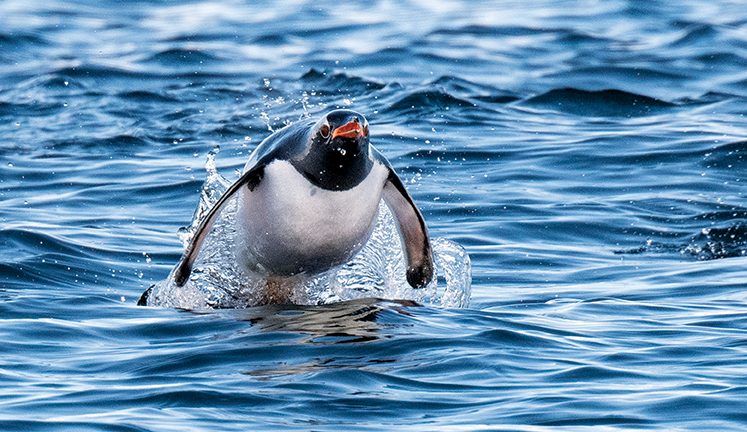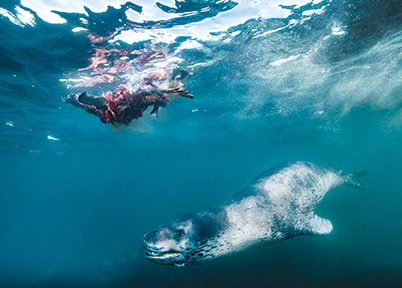Antarctica’s Apex Predator on the Hunt
EVERY PHOTOGRAPHER HAS A DREAM SHOT. For a long time mine was to see a particular natural predation: a leopard seal hunting a penguin in Antarctica. When I traveled to Antarctica for the first time in 2018, I thought it would be a once-in-a-lifetime trip. Little did I know I’d be venturing back repeatedly over the next few years.
On my first trip, we saw several species of penguins, dived icebergs and colorful walls, and snorkeled with crabeater seals. It was nothing short of spectacular, but I really wanted to come face-to-face with a leopard seal underwater. We saw several of them sleeping on icebergs, but unfortunately we had no encounters with them underwater. It became an excellent excuse to rationalize going back.
I returned to Antarctica in 2020 and finally had that spectacular encounter with a leopard seal under brash ice. The seal was curious and swam around us for 90 minutes. After that, I was hooked and really interested in their behaviors, movements, and interactions with humans. Experienced guides in Antarctica told me the seals have chased their rigid inflatable boats (RIBs), sometimes puncturing the tubes or biting the engines, and that they can be territorial animals. While a fatality occurred 20 years ago involving a researcher, there are very few incidences of seals attacking humans.
Antarctica is remote, so I’ve been cautious and watched the seals’ body language during every encounter over the years. Since that first glorious interaction, I’ve been in the water with nine more leopard seals on various trips. Each time I encounter them, I approach slowly and make sure I don’t corner the animal or move sporadically. I let them come to me and investigate my camera, and I watch for any aggressive movements or signs they might bite.

In February 2023 we were in the water with four large seals more than 10 feet long. I’d be lying if I said I wasn’t intimidated, but they seemed as timid as us. We were in the water with them for an hour before getting out due to frozen fingers.
Leopard seals have long, sleek bodies with excellent countershading. It’s difficult to see them below the surface, and that’s part of what makes them incredible predators. They have large heads that look almost reptilian, strong jaws that can open 160 degrees, and mouths full of teeth. They are opportunistic feeders but mostly eat krill, fish, and penguins.
I adore penguins, but having the opportunity to see a leopard seal hunt them was something special I wanted to witness. People have asked why I keep going back to Antarctica. It’s because every trip is different, and I have the opportunity to shoot different behaviors. It takes a lot of persistence to be in the right place at the right time, and it finally came together on my fifth trip.
My dive buddy, Kitrina Godding, and I were enjoying a dive on a kelp wall full of anemones and invertebrates. Just as we decided to surface, her light flashed quickly, telling me something was there. The first of two huge leopard seals appeared and swam up to me, just a foot away from my face. Together they zipped around the wall and darted by us several times.
We surfaced and watched the two seals chase penguins that were fleeing to the shore. There was a lot of action, with penguins jumping all over and the seals dashing toward them, leaving a giant wake. The seals missed a few times, but then after a big splash one had a penguin in its mouth and dragged it underwater to drown. The seal’s massive head popped out of the water and began to shake the penguin to defeather it.

I swam through a cloud of red and feathers, and as the seal came into view, I slowly approached so it didn’t think I was trying to steal its meal. It watched me but was focused on its catch, which it shook violently and threw in the air several times. It was intense but fascinating to see that it didn’t bite and tear it apart as a shark would. It was more methodical and took its time.
At one point the seal threw the carcass, which landed about a foot away from my lens. I began to back up, not wanting to push my luck in this remote location. It was the only time the seal broke away from eating; it came right up to me and pushed its massive snout against my dome port to investigate. I would have loved that mouth-open, toothy shot, but I didn’t want to anger the seal. Instead, I floated there, not moving, and kept shooting video.
The seal quickly swam back to claim its penguin while keeping those big eyes on me. It showed no aggression toward me, and it eventually finished eating, looked around, and then casually swam off.
This encounter was one of the most amazing I’ve had underwater. To see natural predation in a remote and extreme part of the world is indescribable. In-water encounters during my past four trips here had prepared me for this moment. I could anticipate the seal’s movements and body language. Even though every part of me was freezing in the 32°F degree water, I felt nothing, and my instincts to capture the moment kicked in.
I got back on the RIB, and we all cheered with happiness. My friends knew that this encounter was a dream, and sharing it with them made it even better. I’m grateful to our dive guide, Henrik, who kept telling the group he had seen leopard seals in this area on past trips and that it would be a good dive.
I will keep returning to Antarctica because each month from November to March is unique. Antarctica has delivered something magical and memorable every time I’ve been there. It makes me wonder what is in store for next year, and I keep dreaming about the next shot. AD
© Alert Diver — Q3 2023